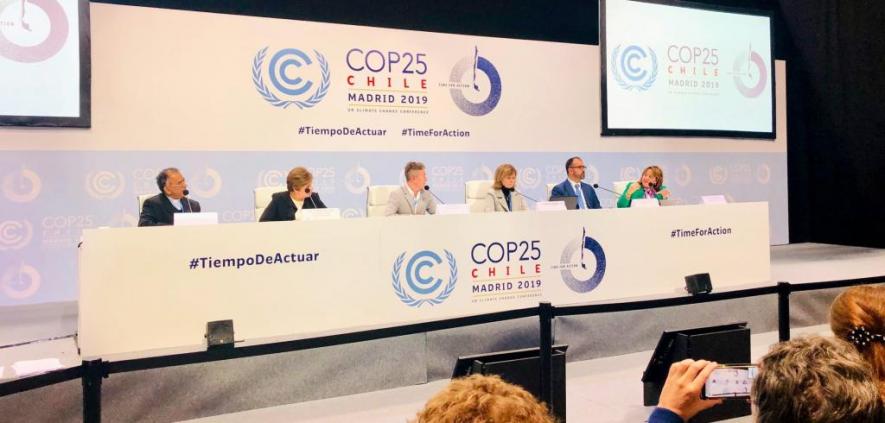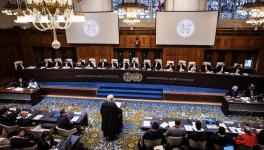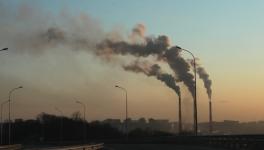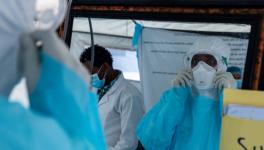Climate Emergency: COP25 Fails in Making Headway?

Image for representational use only.Image Courtesy : DownToEarth
The Conference of the Parties or the COP25, taking place in Spain’s Madrid, has entered a crucial phase of the final round of negotiations before it draws to a close on December 13. COP25 is the final COP before we enter the defining year of 2020, when many nations are expected to submit new climate action plans.
Among the many elements that need to be ironed out is the financing of the climate action worldwide. Currently, not enough is being done to meet the three climate goals: reducing emissions to 45% by 2030, achieving climate neutrality by 2050 (which means a net-zero carbon footprint), and stabilising global temperature rise at 1.5°C by the end of the century.
However, experts believe that conversations at the Summit are dwindling around market mechanics, loss and damage, and voluntary pledges.The Issue of Pre-2020 Carbon Market Mechanism.
The conflict over the mechanism has started to haunt the Madrid negotiations over the new climate market mechanism proposed for the post-2020 Paris Agreement.
The negotiations for the new carbon market regime, which falls under Article 6 of the Paris Agreement, has taken centre stage along with the other outstanding issue of “loss and damage”, thus, limiting the progress of the negotiations.
While developed countries are mostly pushing for a new market-based carbon cut mechanism post-2020, developing countries, led by India, want the developed world to first fulfill their emission reduction commitments made under the Kyoto Protocol before finalising a new market mechanism.
India, supported by like- minded developing countries, and Brazil are demanding that certified emission reductions or CERs, a type of carbon credits issued under the Kyoto protocol, should either be valid under the Paris Agreement or the developing countries should be compensated for discontinuing them.
Issues with Article 6
The main bone of contention is text of Article 6 tries to stay pertinent by stating that a carbon trading system can exist only alongside a net reduction in emissions. However, it doesn’t say anything about how a government can devise such a joint mechanism, given the world’s governments don’t agree with their ideas for a solution. A key issue here is that the Paris Agreement cannot prevent countries from forming their own bilateral or mini-multilateral markets.
The trigger that draws the Agreement’s attention is if a country wants to count a credit traded (on whatever type of market) towards its NDCs. This, in turn, comes in conflict with the principle of Sustainable Development Mechanism (SDM), a centralised, global market designed as the successor to the Clean Development Mechanism (CDM) in the Kyoto Protocol.
It is clear that the SDM will bind countries to a single set of rules, but the governing structure of that mechanism still needs to be fleshed out. Environmental expert D Raghunandan explained, “The whole round of the Kyoto protocol failed primarily because of the market mechanics. For example, planting trees in India costs much less to the European countries than to take mitigation measures in their own territories. Developed countries are able to afford to offset their responsibilities.”
He added, “Market mechanics are operating on the price being attached to carbon, the mechanics could have worked if one had a ceiling. However, with voluntary pledges, this process has failed.” He added, “The conversation is still circling around two things, without anything concrete being achieved, these two things being, how much emissions are going to be reduced and how much money developed countries are giving to the developing ones to have mitigation measures and to adapt to climate change.”
Amidst the negotiations, massive protests are against carbon markets. Many believe, if issues with Article 6 — through which the Paris Agreement deals with carbon markets – are not resolved, this COP could be considered a “failure”.
Another bone of contention at the summit is the lack of clarity over the definition of “overall mitigation of global emissions” (OMGE). This is a key flaw of the CDM under the Kyoto Protocol — that it might have increased rather than decreased the global emissions. However, OMGE itself has not been defined. There is continuing disagreement over whether a definition is needed.
At last year’s conference in Poland, nations had agreed on a set of rules for tracking and reporting greenhouse gas emissions and for reviewing collective progress. However, they failed to establish clear rules about carbon markets through which emissions made in one country can be offset by investing in low-carbon technologies elsewhere.
Although it is unclear whether negotiators will reach an agreement this time, speaking to NewsClick, environmental lawyer Rahul Choudhary said, “Currently, nothing concrete is emerging in terms of the action plan on climate change, both for India and the international community, the targets remain extremely vague and conflicted.”
Get the latest reports & analysis with people's perspective on Protests, movements & deep analytical videos, discussions of the current affairs in your Telegram app. Subscribe to NewsClick's Telegram channel & get Real-Time updates on stories, as they get published on our website.
























